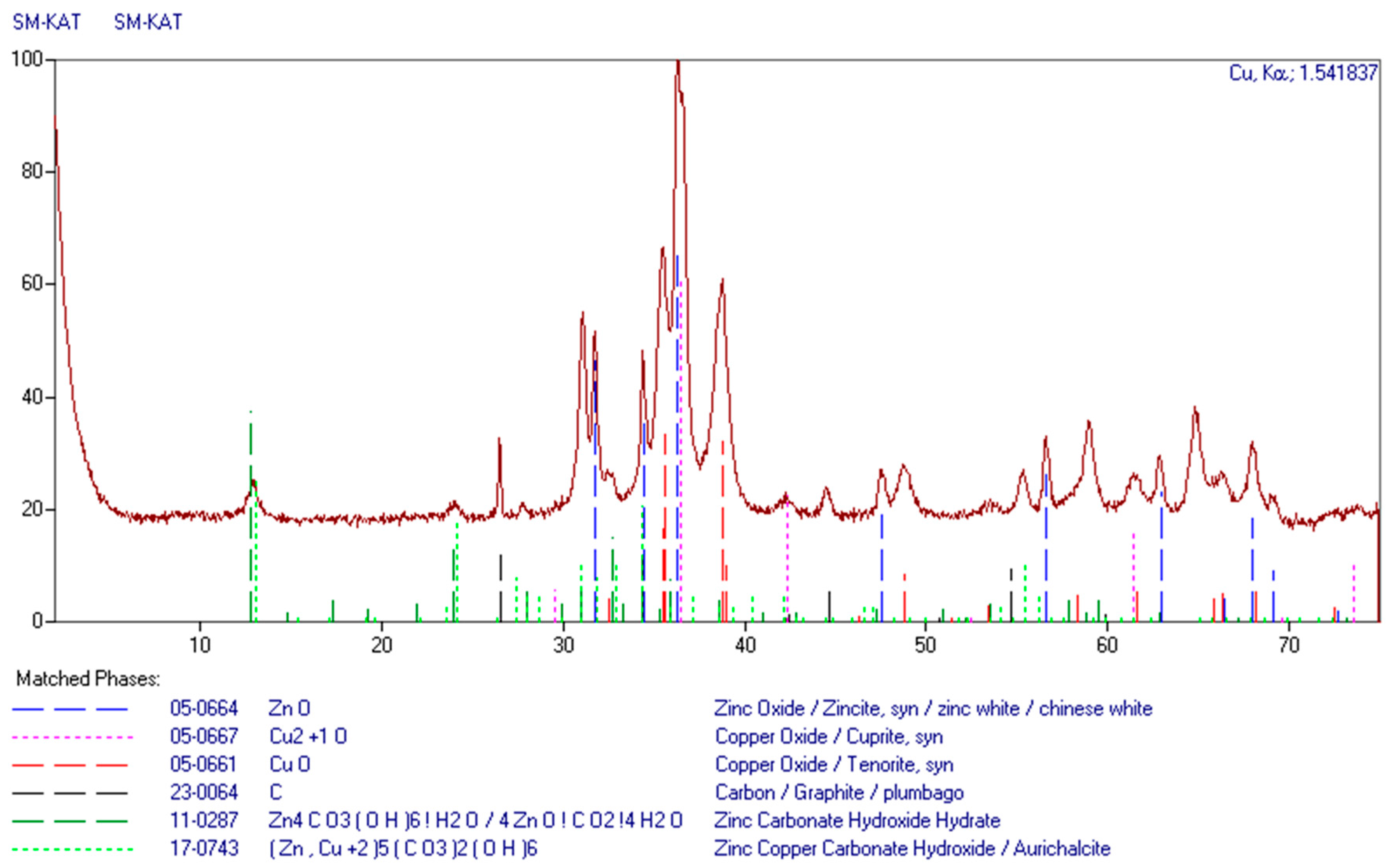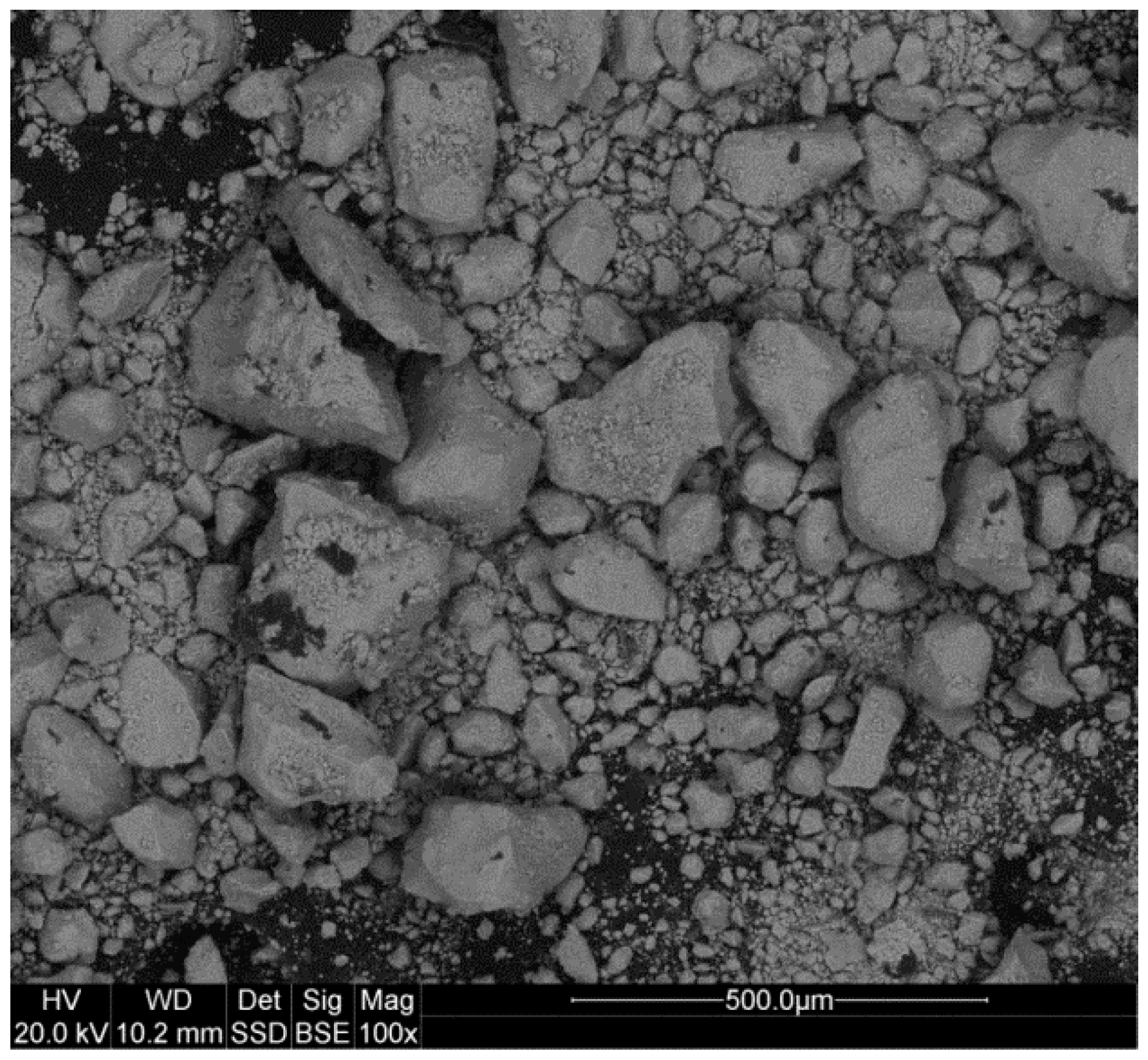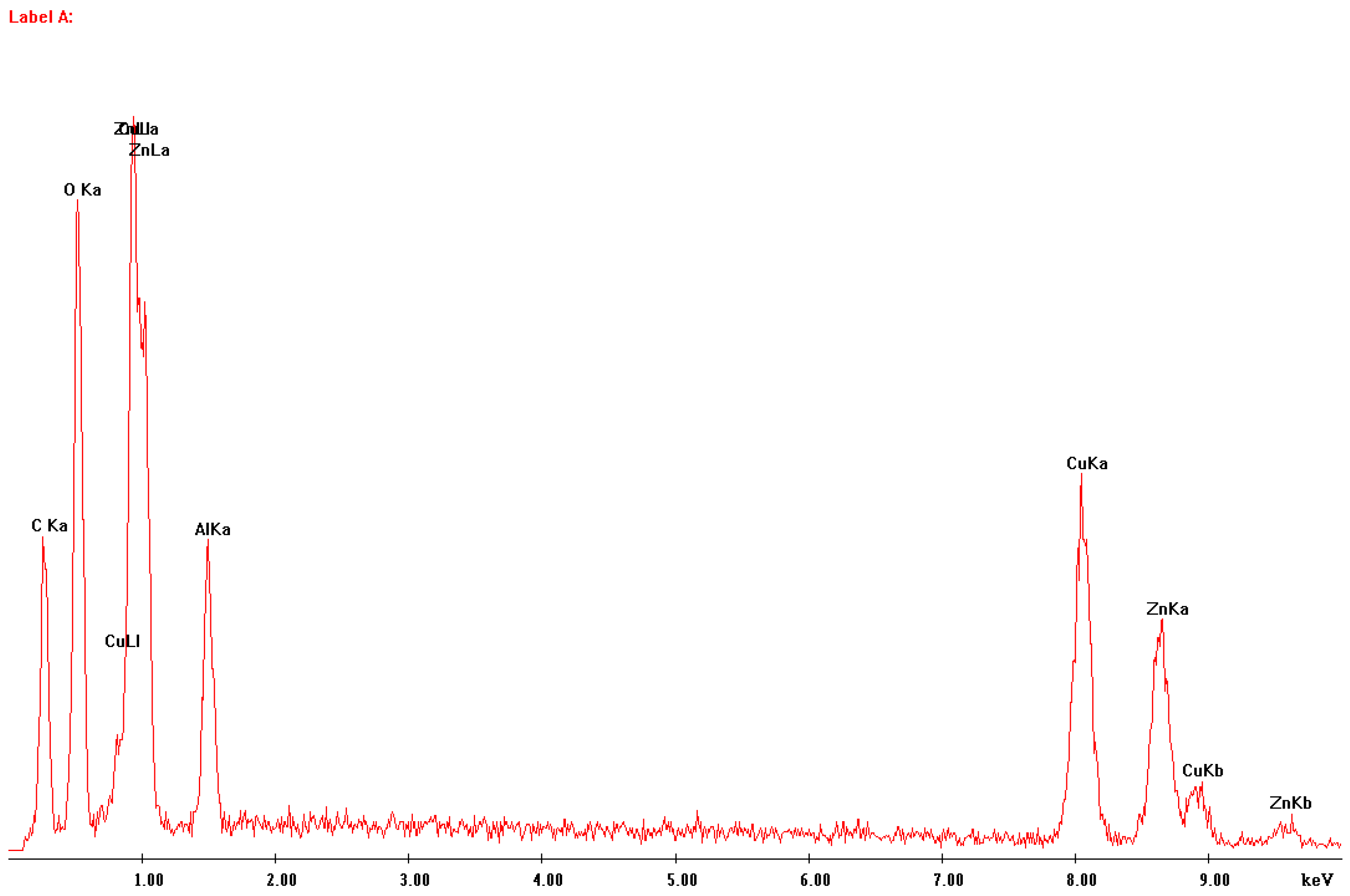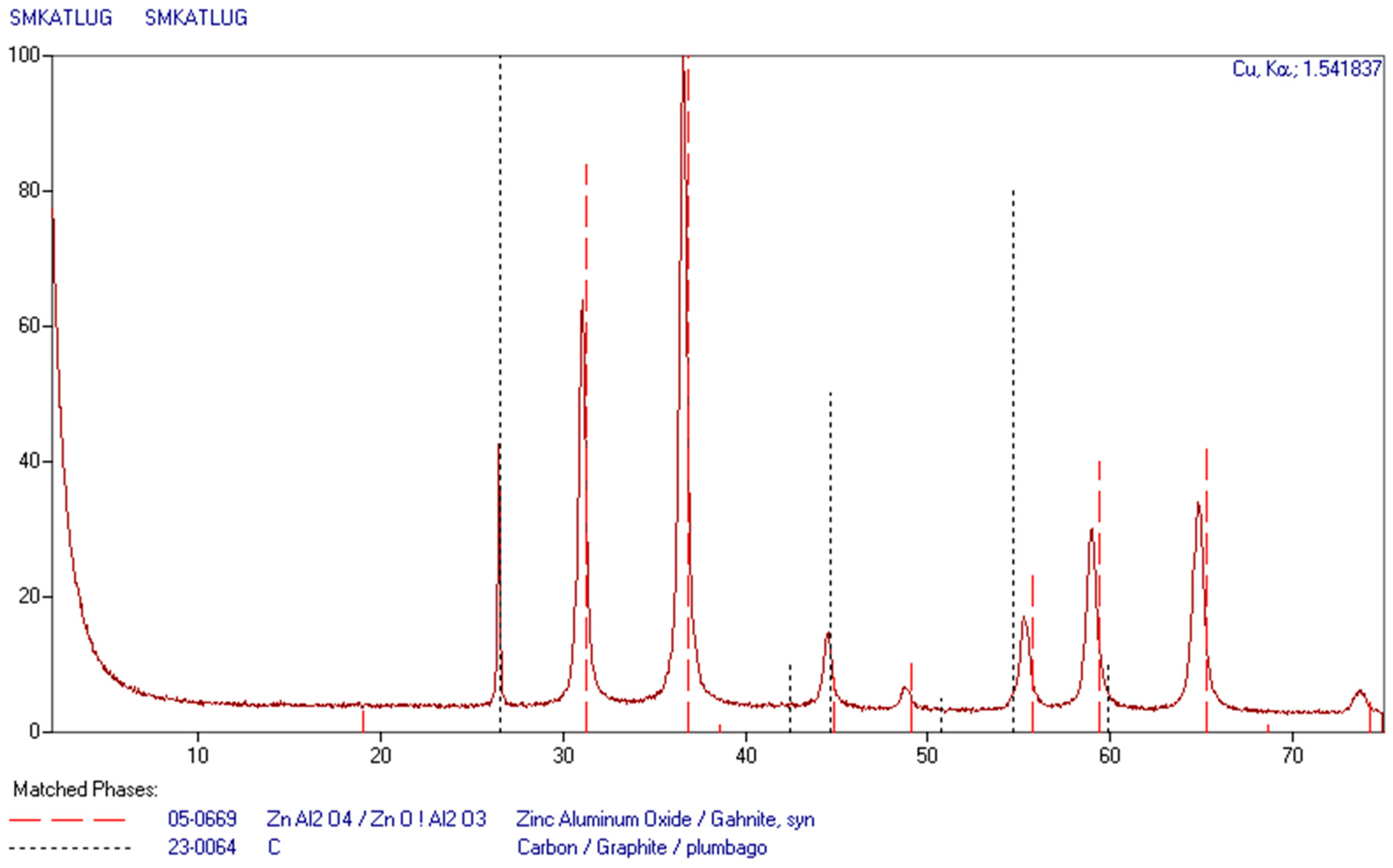Low-Waste Recycling of Spent CuO-ZnO-Al2O3 Catalysts
Abstract
1. Introduction
2. Properties of Examined Material
3. Pyrometallurgical Processing of Spent Catalysts
3.1. Experimental Procedure of Pyrometallurgical Processing
3.2. Results and Discussion of Pyrometallurgical Tests
3.2.1. Test No. 1
3.2.2. Test No. 2
3.2.3. Test No. 3
3.2.4. Test No. 4
4. Processing of Catalysts Using the Hydrometallurgical Method
4.1. Procedure of Hydrometallurgical Tests
- Leaching in NaOH solution (temperature 75 °C, process duration 120 min, NaOH concentration = 200 g/dm3, l/s = 10),
- Leaching in H2SO4 solution (temperature 60 °C, process duration 120 min, H2SO4 concentration = 180 g/dm3, l/s = 10).
4.2. Results and Discussion of Hydrometallurgical Tests
- Zn solution—0.8 dm3 (Zn-23 g/dm3),
- Cu solution—0.8 dm3 (Cu-43 g/dm3),
- ZnAl2O4 deposit in the amount of 33 g.
- Amount of zinc in alkaline solution—18.5 g
- Amount of copper in acidic solution—34.5 g
- Zinc aluminate—30 g
- Carbon—3 g
5. Conclusions
Acknowledgments
Author Contributions
Conflicts of Interest
References
- Sun, Z.; Xiao, Y.; Agterhuis, H.; Sietsma, J.; Yang, Y. Recycling of metals from urban mines—A strategic evaluation. J. Clean. Prod. 2016, 112, 2977–2987. [Google Scholar] [CrossRef]
- Amphlett, J.; Mann, R.; Weir, R. Hydrogen production by the catalytic steam reforming of methanol: Part 3: Kinetics of methanol decomposition using C18HC catalyst. Can. J. Chem. Eng. 1988, 66, 950–955. [Google Scholar] [CrossRef]
- Agarwal, V.; Patel, S.; Pant, K.K. H2 production by steam reforming of methanol over Cu/ZnO/Al2O3 catalysts: Transient deactivation kinetics modelling. Appl. Catal. A 2005, 279, 155–164. [Google Scholar] [CrossRef]
- Waugh, K.C. Methanol Synthesis. Catal. Lett. 2012, 142, 1153–1166. [Google Scholar] [CrossRef]
- Riaz, A.; Zahedi, G.; Klemes, J.J. A review of cleaner production methods for the manufacture of methanol. J. Clean. Prod. 2013, 57, 19–37. [Google Scholar] [CrossRef]
- Behrens, M.; Studt, F.; Kasatkin, I.; Kühl1, S.; Hävecker, M.; Abild-Pedersen, F.; Zander, S.; Girgsdies, F.; Kurr, P.; Kniep, B.L.; et al. The Active Site of Methanol Synthesis over Cu/ZnO/Al2O3 Industrial Catalysts. Science 2012, 336, 893–897. [Google Scholar] [CrossRef] [PubMed]
- Barroso, M.N.; Gomez, M.F.; Gamboa, J.A.; Arrua, L.A.; Abello, M.C. Preparation and characterization of CuZnAl catalysts by citrate gel process. J. Phys. Chem. Solids 2006, 67, 1583–1589. [Google Scholar] [CrossRef]
- Turco, M.; Bagnasco, G.; Costantino, U.; Marmottini, F.; Montanari, T.; Ramis, G.; Busca, G. Production of hydrogen from oxidative steam reforming of methanol: II. Catalytic activity and reaction mechanism on Cu/ZnO/Al2O3 hydrotalcite-derived catalysts. J. Catal. 2004, 228, 56–65. [Google Scholar] [CrossRef]
- Walerczyk, W.; Zawadzki, M.; Grabowska, H. Glycothermal synthesis and catalytic properties of nanosized Zn1−xCoxAl2O4 (x = 0, 0.5, 1.0) spinels in phenol methylation. Catal. Lett. 2011, 141, 592–601. [Google Scholar] [CrossRef][Green Version]
- Zhou, H.; Huang, Y. Method for Recycling Waste Copper-Based Methanol Waste Catalyst. Patent CN103495426A, 18 January 2014. [Google Scholar]
- Wang, B.; Meng, Y. Recovery Method of Copper and Zinc Oxide from Waste Copper-Zinc Catalyst. Patent CN1258752A, 30 December 1998. [Google Scholar]
- Ling, H.; Liu, J.; Zhang, X.; Xu, X.; Li, Q.; Hu, Z.; Hu, G.; Qiu, C.; Huang, H. Application Method of Waste Copper Based Catalyst to Preparing Catalyst for Preparing Hydrogen from Methanol. Patent CN102125851A, 20 April 2011. [Google Scholar]
- Bunting, E.N. Phase equilibria in the system SiO2-ZnO. J. Am. Ceram. Soc. 1930, 13, 5–10. [Google Scholar] [CrossRef]
- Kracek, F.C. The system sodium oxide-silica. J. Phys. Chem. 1930, 34, 1583–1598. [Google Scholar] [CrossRef]
- Holland, A.E.; Segnit, E.R. The ternary system Na2O-ZnO-SiO2. Aust. J. Chem. 1966, 19, 905–913. [Google Scholar] [CrossRef]
- Segnit, E.R. The System CaO-ZnO-SiO2. J. Am. Ceram. Soc. 1954, 37, 273–277. [Google Scholar] [CrossRef]
- Segnit, E.R. Three planes in the quaternary system CaO-ZnO-Al2O3-SiO2. J. Am. Ceram. Soc. 1962, 45, 600–607. [Google Scholar] [CrossRef]
- Tang, Y.; Shih, K.; Wang, Y.; Chong, T. Zinc stabilization efficiency of aluminate spinel structure and its leaching behaviour. Environ. Sci. Technol. 2011, 45, 10544–10550. [Google Scholar] [CrossRef] [PubMed]
- Gargul, K.; Jarosz, P.; Małecki, S. Alkaline leaching of low zinc content iron-bearing sludges. Arch. Metall. Mater. 2016, 61, 43–50. [Google Scholar] [CrossRef][Green Version]




| Process Parameters | Smelting Variant | |||
|---|---|---|---|---|
| I | II | III | IV | |
| FEED | ||||
| Mass of catalysts (g) | 100 | 100 | 100 | 100 |
| Mass of silica (g) | 50 | 60 | 55.4 | 28 |
| Mass of carbon (g) | 10 | 10 | 10 | 10 |
| Mass of CaO (g) | 15 | - | - | - |
| Mass of Na2CO3 (g) | - | - | 31 | 16 |
| Mass of NaOH (g) | - | 20 | - | - |
| Smelting time (min) | 45 | 50 | 90 | 90 |
| Process temperature (°C) | 1300 | 1300 | 1250 | 1250 |
| PRODUCTS | ||||
| The overall mass of the alloy (g) | 26 | 25 | 25 | 20 |
| Mass of Cu in the alloy (g) | 23.2 | 22.1 | 22.0 | 17.7 |
| Mass of Zn in the alloy (g) | 2.5 | 2.7 | 2.8 | 2.3 |
| Mass of slag (g) | 62 | 95 | 107 | 61 |
| Mass of copper in the slag (g) | 6.4 | 7.5 | 7.6 | 11.9 |
| Mass of zinc in the slag (g) | 6.0 | 6.1 | 6.7 | 6.3 |
| The copper yield in the alloy (%) | 66.1 | 63.0 | 62.7 | 50.4 |
| The estimated yield of zinc in the dust (%) | 71.6 | 70.6 | 68.2 | 71.2 |
© 2018 by the authors. Licensee MDPI, Basel, Switzerland. This article is an open access article distributed under the terms and conditions of the Creative Commons Attribution (CC BY) license (http://creativecommons.org/licenses/by/4.0/).
Share and Cite
Małecki, S.; Gargul, K. Low-Waste Recycling of Spent CuO-ZnO-Al2O3 Catalysts. Metals 2018, 8, 177. https://doi.org/10.3390/met8030177
Małecki S, Gargul K. Low-Waste Recycling of Spent CuO-ZnO-Al2O3 Catalysts. Metals. 2018; 8(3):177. https://doi.org/10.3390/met8030177
Chicago/Turabian StyleMałecki, Stanisław, and Krzysztof Gargul. 2018. "Low-Waste Recycling of Spent CuO-ZnO-Al2O3 Catalysts" Metals 8, no. 3: 177. https://doi.org/10.3390/met8030177
APA StyleMałecki, S., & Gargul, K. (2018). Low-Waste Recycling of Spent CuO-ZnO-Al2O3 Catalysts. Metals, 8(3), 177. https://doi.org/10.3390/met8030177





